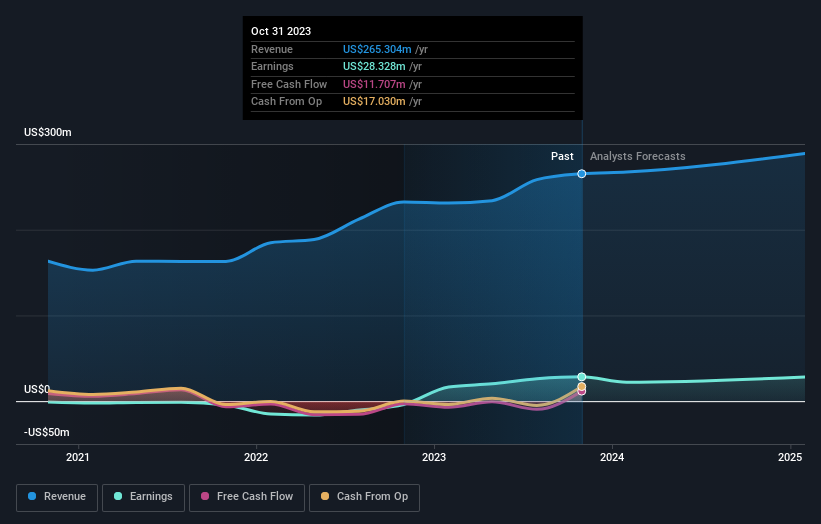Virco Mfg. Corporation's (NASDAQ:VIRC) insiders are still the largest shareholders with 42% stake despite recent sales
Key Insights
Virco Mfg's significant insider ownership suggests inherent interests in company's expansion
The top 7 shareholders own 50% of the company
If you want to know who really controls Virco Mfg. Corporation (NASDAQ:VIRC), then you'll have to look at the makeup of its share registry. And the group that holds the biggest piece of the pie are individual insiders with 42% ownership. Put another way, the group faces the maximum upside potential (or downside risk).
Insiders are at the top of the company's shareholdings despite selling some shares recently. As a result, they were also the biggest winners as market cap hit US$164m last week.
Let's take a closer look to see what the different types of shareholders can tell us about Virco Mfg.
Check out our latest analysis for Virco Mfg
What Does The Institutional Ownership Tell Us About Virco Mfg?
Institutional investors commonly compare their own returns to the returns of a commonly followed index. So they generally do consider buying larger companies that are included in the relevant benchmark index.
Virco Mfg already has institutions on the share registry. Indeed, they own a respectable stake in the company. This suggests some credibility amongst professional investors. But we can't rely on that fact alone since institutions make bad investments sometimes, just like everyone does. If multiple institutions change their view on a stock at the same time, you could see the share price drop fast. It's therefore worth looking at Virco Mfg's earnings history below. Of course, the future is what really matters.
Hedge funds don't have many shares in Virco Mfg. The company's CEO Robert Virtue is the largest shareholder with 19% of shares outstanding. In comparison, the second and third largest shareholders hold about 8.4% and 6.7% of the stock.
We did some more digging and found that 7 of the top shareholders account for roughly 50% of the register, implying that along with larger shareholders, there are a few smaller shareholders, thereby balancing out each others interests somewhat.
Researching institutional ownership is a good way to gauge and filter a stock's expected performance. The same can be achieved by studying analyst sentiments. There is a little analyst coverage of the stock, but not much. So there is room for it to gain more coverage.
Insider Ownership Of Virco Mfg
While the precise definition of an insider can be subjective, almost everyone considers board members to be insiders. The company management answer to the board and the latter should represent the interests of shareholders. Notably, sometimes top-level managers are on the board themselves.
Insider ownership is positive when it signals leadership are thinking like the true owners of the company. However, high insider ownership can also give immense power to a small group within the company. This can be negative in some circumstances.
Our information suggests that insiders maintain a significant holding in Virco Mfg. Corporation. Insiders have a US$69m stake in this US$164m business. We would say this shows alignment with shareholders, but it is worth noting that the company is still quite small; some insiders may have founded the business. You can click here to see if those insiders have been buying or selling.
General Public Ownership
The general public, who are usually individual investors, hold a 32% stake in Virco Mfg. While this size of ownership may not be enough to sway a policy decision in their favour, they can still make a collective impact on company policies.
Next Steps:
It's always worth thinking about the different groups who own shares in a company. But to understand Virco Mfg better, we need to consider many other factors. Be aware that Virco Mfg is showing 2 warning signs in our investment analysis , you should know about...
If you would prefer discover what analysts are predicting in terms of future growth, do not miss this free report on analyst forecasts.
NB: Figures in this article are calculated using data from the last twelve months, which refer to the 12-month period ending on the last date of the month the financial statement is dated. This may not be consistent with full year annual report figures.
Have feedback on this article? Concerned about the content? Get in touch with us directly. Alternatively, email editorial-team (at) simplywallst.com.
This article by Simply Wall St is general in nature. We provide commentary based on historical data and analyst forecasts only using an unbiased methodology and our articles are not intended to be financial advice. It does not constitute a recommendation to buy or sell any stock, and does not take account of your objectives, or your financial situation. We aim to bring you long-term focused analysis driven by fundamental data. Note that our analysis may not factor in the latest price-sensitive company announcements or qualitative material. Simply Wall St has no position in any stocks mentioned.


